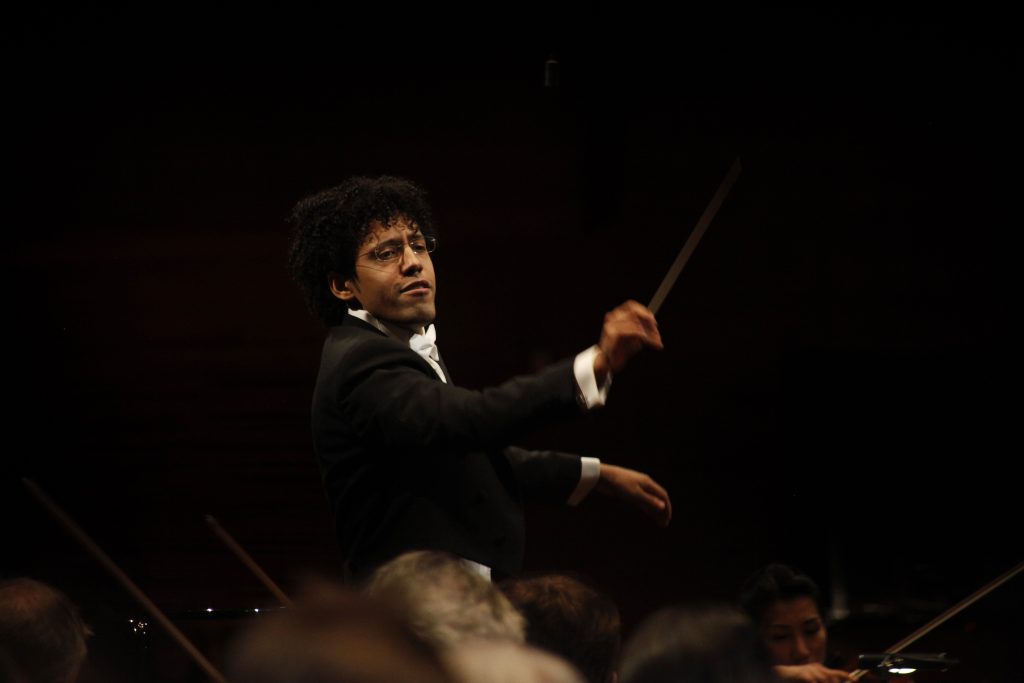Rafael Payare Conducts the San Diego Symphony in Salonen, Ravel, and Debussy at The Rady Shell
Before Saturday’s San Diego Symphony concert began I had doubts that Esa-Pekka Salonen’s 2010 “Nyx” was the right match for Music Director Rafael Payare’s Impressionist program devoted to Claude Debussy and Maurice Ravel. After hearing the San Diego Symphony play “Nyx,” I decided I was right on one count. Salonen’s harmonic vocabulary and melodic structures are not close to those of the French masters of musical Impressionism.
However, Salonen’s transparent textures and highly imaginative orchestration that generously distributed unencumbered solos across the orchestra—especially to unusual solo candidates such as the tuba and celesta—make him a congenial fellow traveller with these Impressionists, especially to Ravel. Salonen opens “Nyx” with a cascade of bright horn calls that dash in and out throughout the piece, and after a serious full orchestra contrapuntal flurry, he unveils his parade of ingratiating solos and duos. Kudos to Principal Clarinet Sheryl Renk who did so much of the heavy lifting with her usual finesse and suave timbre, and to Principal Harp Julie Smith Phillips whose airy duo with the celesta proved magical. Anticipating the climax of “Nyx,” the composer works the strings into a turbulent rush that does not cadence the piece, but instead dissolves into a quiet, ominous theme from the cellos followed by a shortened echo of the opening horn flourish. Salonen accomplishes in a mere 20 minutes what I wish Richard Strauss had accomplished in his patience testing 40-minute tone poems!In the first decade of the 20th century, Ravel’s charming Mother Goose Suite began as a set of five four-hand piano pieces the composer wrote for two young music students based on five tales from Charles Perrault’s 1697 Contes de ma Mère l’Oye. At Ravel’s publisher’s insistence, he brilliantly orchestrated the suite, to which Payare turned this week after his German guest violin soloist Veronica Eberle experienced visa complications and could not make it to San Diego to perform the scheduled Prokofiev Violin Concerto in D Major.
Payare and the orchestra captured Ravel’s delight depicting the endearing fairy tale figures—a sad pavane for Sleeping Beauty, a skittering theme for Tom Thumb, a low growl for Beauty’s beast—while keeping his sophisticated structures in immaculate balance. The musicians adroitly delineated Ravel’s charming modal melodies as well as his polished contrapuntal flourishes, which The Rady Shell’s superlative sound system transmitted with amazing fidelity, especially considering the amount of unenclosed space in the Symphony’s commodious bay-side facility. Although many instrumental solos warranted praise, I would be remiss if I did not salute flutist Diana Morgan for filling in at the last moment for Principal Flute Rose Lombardo. In this score, Ravel entrusts some of his most effusive solos to the first-chair flute, and Morgan’s bright, gleaming sound and technical finesse met his every challenge.
Debussy’s tone poem La Mer and Ravel’s ballet Daphnis et Chloé, both from that fertile opening decade of the last century, remain icons of the musical style we call Impressionism, even though we know that Debussy rejected this label because he claimed the Symbolist poets were his inspiration, not those over-praised painters! Payare’s approach to La Mer emphasized its drama and emotional sweep, even in its calmer sections.
In Eric Bromberger’s always insightful printed program notes, he makes this astute observation about Debussy and La Mer, “Debussy was not interested in musical scene-painting but in writing music that makes us feel the way we feel in the presence of the ocean.” And I believe that is what the orchestra’s gripping, muscular interpretation accomplished on Saturday.
In Daphnis et Chloé on the other hand, Ravel does relish tone painting, and the orchestra gave an exhilarating account of his masterful orchestral swells that depict a glorious sunrise in the opening movement “From Dawn to Noon on the Sea.” I particularly appreciated Andrea Overturf’s agitated and engaging English Horn solos in the middle movement “Play of the Waves” and the scintillating volleys from the trumpet section that open the final movement “Dialogue of Wind and Sea.” In the sumptuous finale of that movement, Payare unleashed the composer’s ferocity without sacrificing focus, a feat far more difficult to accomplish than to simply praise.
This concert was performed by the San Diego Symphony at The Rady Shell at Jacobs Park on May 21 & 22, 2022. The May 21 performance was attended for this review.

Ken Herman, a classically trained pianist and organist, has covered music for the San Diego Union, the Los Angeles Times’ San Diego Edition, and for sandiego.com. He has won numerous awards, including first place for Live Performance and Opera Reviews in the 2017, the 2018, and the 2019 Excellence in Journalism Awards competition held by the San Diego Press Club. A Chicago native, he came to San Diego to pursue a graduate degree and stayed.Read more…


“ Salonen accomplishes in a mere 20 minutes what I wish Richard Strauss had accomplished in his patience testing 40-minute tone poems!”
Heresy. Ha.